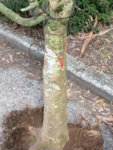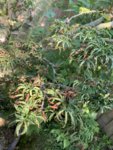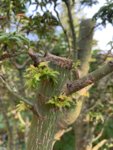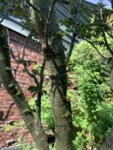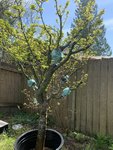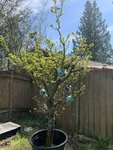Maloghurst
Chumono
I collected a huge shishigashira today. It was headed for the compost tomorrow so I went for it.
The pic probably does not do justice to the size. Also I’m not 100% on cultivar because I haven’t seen the leaves yet. But the internodes look like shishi. The rootball in the pic is about 26x40” across. The trunk is about 8” across. The nebari is more like 20”. The tree was about 15” tall. I cut everything back to much lower branching and left as much rootball as I could manage.
The soil was very crumbling so by the time I got it into a pot it was mostly bareroot. There are still some fine roots but not enough to make me confident of survival. I secured the tree in a huge nursery pot with Maloghurst bonsai soil ?.
I’m not very optimistic as the buds have just broken and not the best time for this and the rootball was as large as I could get without a small crane.
My questions
1. could I get air layers from this as I expect it to fully leaf out even if it’s dead in the long run. Could there be enough energy in the tree to air layer? I really do not expect it to make it two years.
2. For best chance of survival should I take anymore of the branching off? As stated I took probably 80% off already beacause the tree was Huge.
3. I don’t see any buds below what appears to be the graft about 40” up the trunk. But I could just do a hard chop about 30” up and hope for the best?
4.. Do shishigashira root well from cuttings because I have a ton.
Thank you!
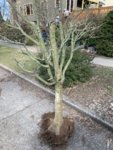
The pic probably does not do justice to the size. Also I’m not 100% on cultivar because I haven’t seen the leaves yet. But the internodes look like shishi. The rootball in the pic is about 26x40” across. The trunk is about 8” across. The nebari is more like 20”. The tree was about 15” tall. I cut everything back to much lower branching and left as much rootball as I could manage.
The soil was very crumbling so by the time I got it into a pot it was mostly bareroot. There are still some fine roots but not enough to make me confident of survival. I secured the tree in a huge nursery pot with Maloghurst bonsai soil ?.
I’m not very optimistic as the buds have just broken and not the best time for this and the rootball was as large as I could get without a small crane.
My questions
1. could I get air layers from this as I expect it to fully leaf out even if it’s dead in the long run. Could there be enough energy in the tree to air layer? I really do not expect it to make it two years.
2. For best chance of survival should I take anymore of the branching off? As stated I took probably 80% off already beacause the tree was Huge.
3. I don’t see any buds below what appears to be the graft about 40” up the trunk. But I could just do a hard chop about 30” up and hope for the best?
4.. Do shishigashira root well from cuttings because I have a ton.
Thank you!


